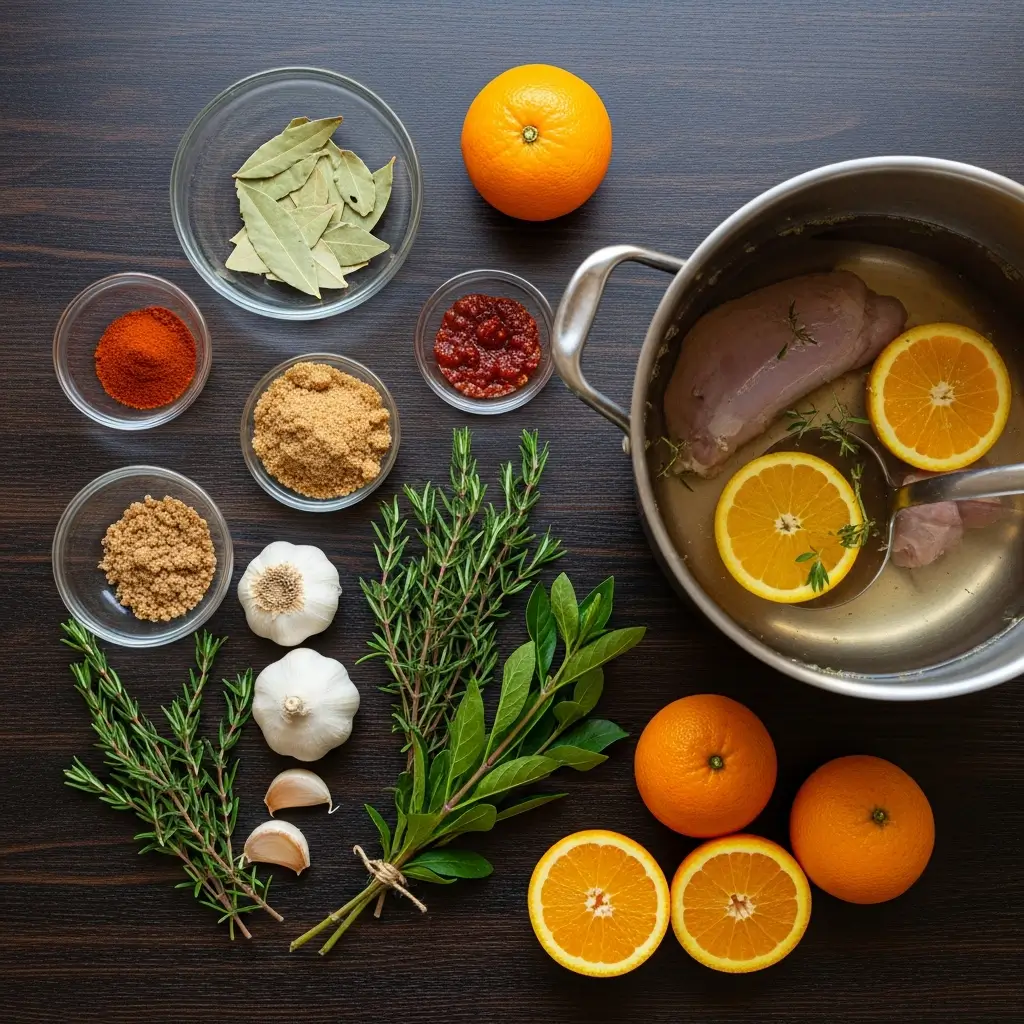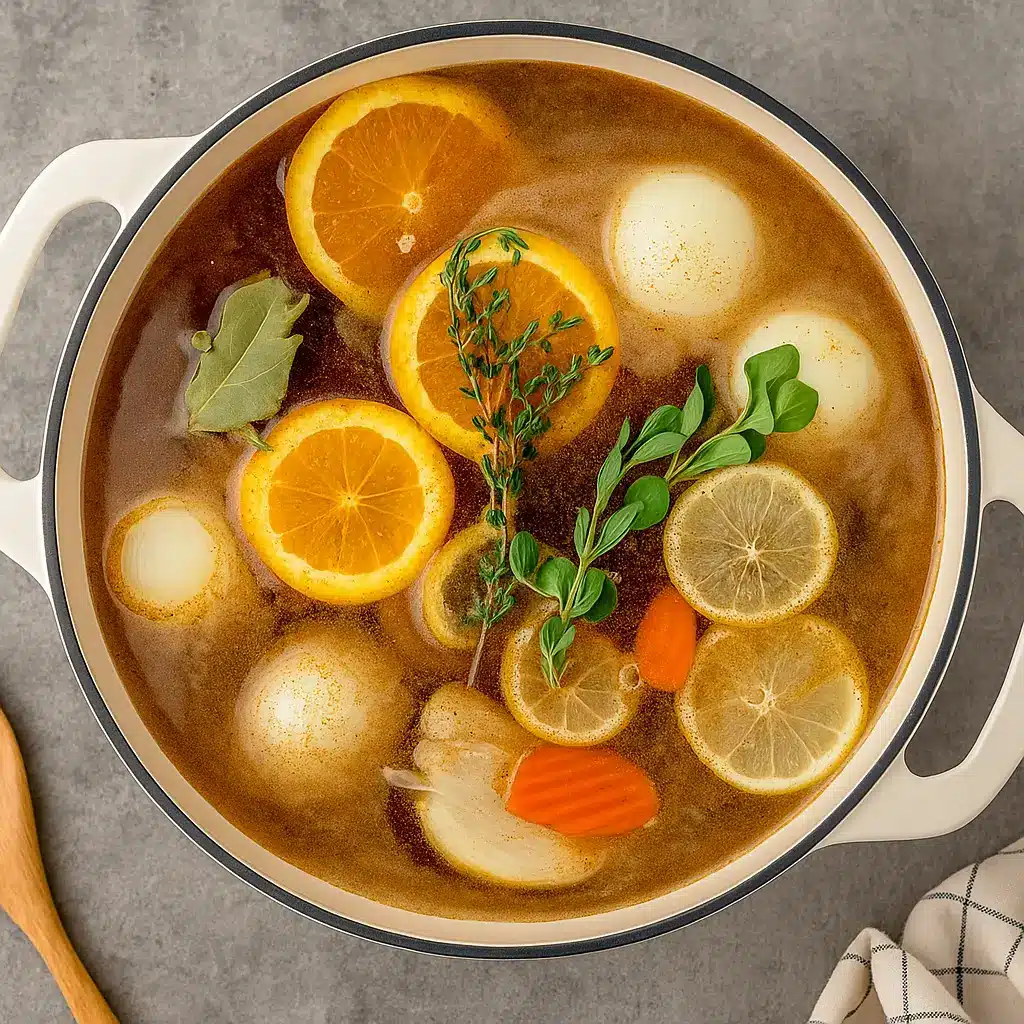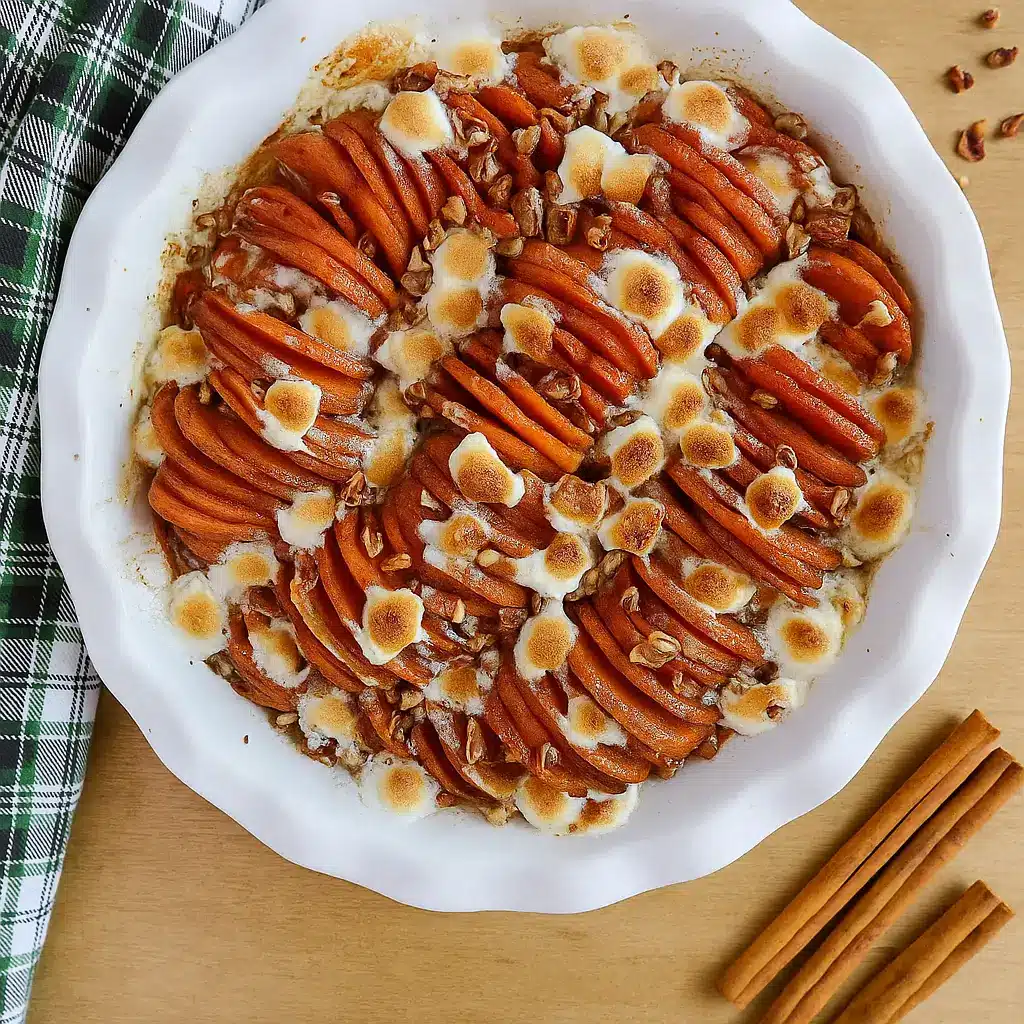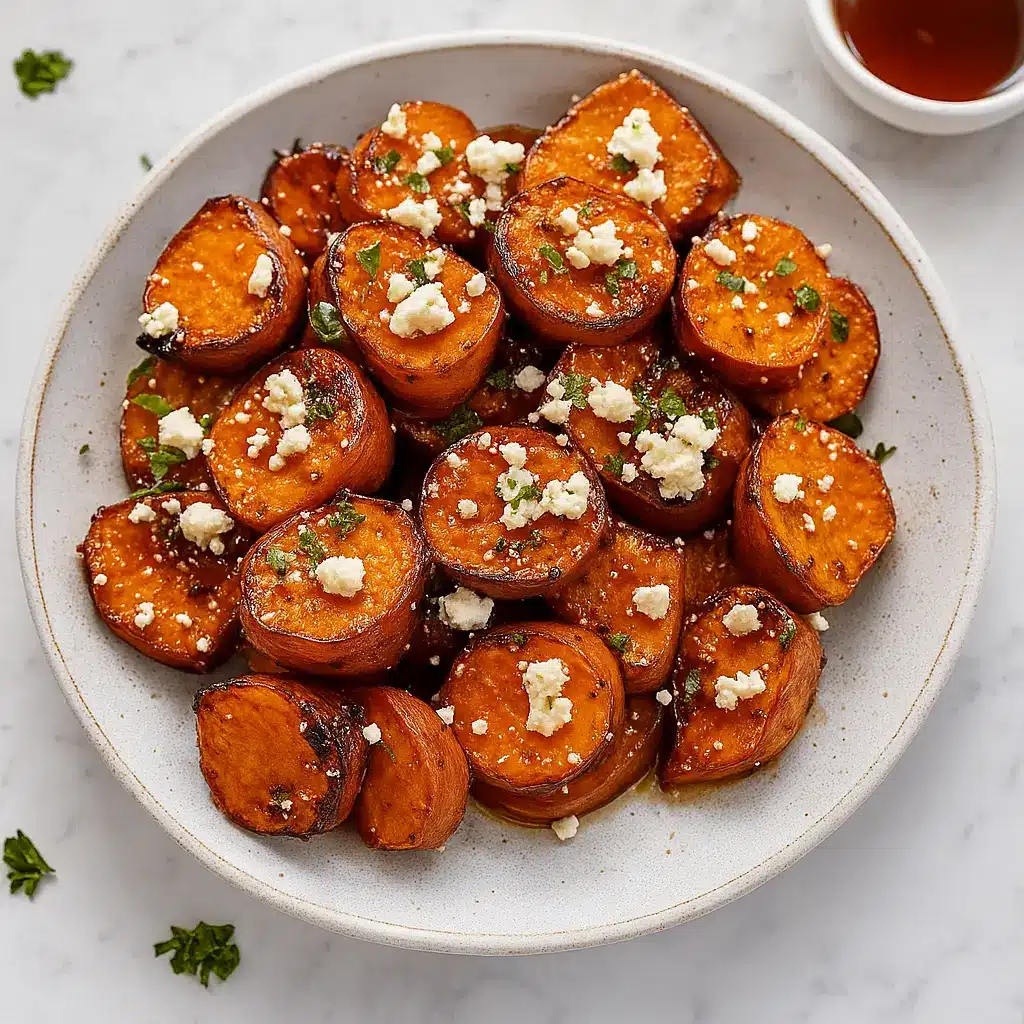Let’s be real—Thanksgiving is not the day to gamble with your turkey. A dry bird can bring a whole dinner table to a silent standstill faster than Aunt Carol’s political opinions. But fear not! A good turkey brine recipe is the secret weapon for moist, flavorful, “can-I-get-seconds” turkey that practically carves itself. This recipe? It’s not just some saltwater spa day for your bird.
It’s a flavor-infused soak loaded with spices, herbs, and aromatics that turn even the most basic turkey into a showstopper. Whether you’re roasting, frying, or smoking, this turkey brine recipe lays the foundation for success—no gravy flood necessary.
Table of Contents
What is a Turkey Brine Recipe?
A turkey brine recipe is essentially a pre-game strategy that makes your Thanksgiving bird juicy, tender, and flavorful. At its core, it’s a saltwater bath infused with herbs, spices, and aromatics, where the turkey takes a long, relaxing soak. Brining helps the meat absorb moisture and seasoning, which means even if you accidentally overcook it (hey, it happens), you’ve still got a fighting chance at juicy slices.
This wet brining method is especially helpful for lean birds like turkey, which can dry out easily. Think of it like giving your turkey a marinade and a moisture shield in one.
Reasons to Try a Turkey Brine Recipe
First: flavor, flavor, flavor. Second: insurance against dry turkey. Third? It’s surprisingly easy. With a turkey brine recipe, you’re not just seasoning the surface—you’re infusing flavor deep into the meat. Plus, it’s totally customizable. Want citrus notes? Add orange zest. Craving cozy fall vibes? Toss in cinnamon and cloves. A good brine also works wonders for texture—your turkey will be so tender that you’ll wonder how you ever cooked without it. And since most of the work happens while the bird’s chilling in the fridge, it’s perfect for busy home cooks. That’s a win for flavor and your sanity.
Ingredients Needed to Make Turkey Brine Recipe
- 12-pound whole turkey
- 16 cups water
- 1 tablespoon paprika
- 1 tablespoon chili powder
- 1 tablespoon garlic powder
- 1 yellow onion, quartered
- 2 sprigs fresh oregano
- 2 sprigs fresh thyme
- 5 garlic cloves, lightly smashed
- 1/4 cup brown sugar
- 4 dried bay leaves
- 3/4 cup Morton’s coarse kosher salt (or 1 cup Diamond Crystal)
- 4 cups ice
Optional add-ins for extra flavor:
- Orange zest or slices
- Lemon zest or slices
- Carrots, sliced
- Celery, chopped
- Fresh parsley
- Cinnamon sticks
- Whole cloves
- Star anise pods
- Apple juice or apple cider

Instructions to Make Turkey Brine Recipe (Focus: Step-by-Step Guide)
Brining a turkey may sound fancy, but it’s actually one of the simplest things you can do to guarantee a juicy, flavorful bird. This step-by-step turkey brine guide will walk you through the entire process—from prepping your turkey to sealing the brining bag—so you feel confident every step of the way. Whether you’re roasting, smoking, or frying your bird, this method lays the groundwork for a turkey that’s tender and full of flavor. Ready? Let’s dive in.
Step 1: Prep the Turkey for Brining
Start your step-by-step turkey brine journey by preparing the bird. Remove the turkey from its packaging and take out the neck and giblets (usually tucked in the cavity—don’t forget them!). While some people toss them, others use them for stock or savory turkey gravy, so save them if you’d like.
Give the turkey a gentle rinse under cold water, then pat it dry with paper towels. Place it into your brining vessel of choice—a large stockpot, clean cooler, or a brining bag set in a roasting pan. Choose a container that fits both the turkey and enough liquid to fully submerge it. If you’re short on fridge space, a cooler in a cold garage (below 40°F) works great.
Tip: For more advice on safe food handling and how to prep your workspace, check out our kitchen prep tips.
Step 2: Make the Flavorful Brine
Next in our step-by-step process is creating the actual brine. In a large stockpot, bring 16 cups of water to a boil over high heat. Once boiling, whisk in the paprika, chili powder, garlic powder, quartered onion, fresh oregano, thyme, smashed garlic, brown sugar, bay leaves, and kosher salt.
This is where the magic happens—the simmering helps release the oils and aromas from the spices and herbs, infusing the brine with layers of flavor. If you’re feeling creative, this is also the time to add optional flavor-boosters like orange slices, apple cider, cinnamon sticks, or cloves. These additions give your turkey an aromatic boost that your guests will notice before the first bite.
Let the mixture simmer for 15 to 20 minutes, stirring occasionally. Your kitchen should start smelling like Thanksgiving in a pot.
Step 3: Cool the Brine Completely
Before adding the brine to the turkey, you must cool it down. Pour in 4 cups of ice to help drop the temperature quickly. Then allow the brine to rest until it reaches room temperature. This is an essential step-by-step safety measure—adding hot brine to raw poultry is a no-go, as it can lead to bacteria growth.
Don’t skip this cooling phase. If you’re in a hurry, place the pot in a sink filled with cold water to speed things up. For more on how to safely cool liquids quickly, visit our ingredient safety guide.
Step 4: Submerge the Turkey in the Brine
Once the brine has cooled, carefully pour it over your turkey in the brining bag or container. This is usually a two-person job—brine has a sneaky way of sloshing everywhere if you’re solo. Slowly pour the mixture to fully coat the bird, then press out as much air as possible from the bag before sealing it tightly with kitchen twine or the bag’s zip tie.
Make sure the turkey is completely submerged. If it’s floating or peeking out, use a small heavy bowl or even a clean cheese grater (yes, really) to weigh it down. Place the container in the refrigerator—or in a cooler with ice packs if you’re short on fridge space—and let it soak for 24 hours. For turkeys over 15 pounds, you can brine for up to 36 hours.
Tip: Want to know the best turkey size for your gathering? Our Thanksgiving planning guide has tips on serving sizes and leftovers.
Step 5: Remove, Dry, and Prep for Roasting
After your turkey has enjoyed its flavorful soak, remove it from the brine. Discard the used brine (it’s done its job). Pat the turkey completely dry with paper towels—this helps the skin crisp up during cooking. There’s no need to rinse the bird; in fact, USDA guidelines recommend skipping the rinse to avoid splashing bacteria around your sink area.
Before you start seasoning or buttering the bird, reduce any added salt in your rub or compound butter recipes by at least half—remember, the brine already seasoned the meat from the inside out.
At this point, you can proceed with your favorite turkey roasting method. For a foolproof option, try our reader-favorite Dry-Brined Spatchcock Turkey or use the meat in something cozy like our Leftover Turkey Soup.
What to Serve with Turkey Brine Recipe
A beautifully brined turkey deserves sides that play up its flavor. Think creamy, tangy, sweet, and herby to balance the richness. A classic mash and gravy situation is always welcome, but don’t stop there. Try our Cinnamon Honey Butter Sweet Potato Cornbread or Savory Butternut Squash Sage Pasta for a warm autumn twist. Want something fresh? A crisp green bean almondine or zesty cranberry relish will cut through that savory richness like a charm. Round it out with some apple cider punch, and you’ve got yourself a celebration.
Key Tips for Making Turkey Brine Recipe
- Salt matters. Morton’s and Diamond Crystal are not equal—use the correct amount based on which brand you have.
- Cool the brine fully before adding it to the turkey. Hot liquid + raw poultry = a food safety red flag.
- Brine bag hack: If you don’t have a brining bag, use a clean cooler and line it with a roasting bag instead.
- Don’t overdo the time. Longer isn’t always better. Over-brining can lead to mushy texture and over-salted meat.
- Skip rinsing. Just pat dry. The USDA says no rinse, and honestly, it keeps things neater.
Storage and Reheating Tips for Turkey Brine Recipe
Once your turkey is brined and cooked, let it rest before slicing. Leftovers? Store them in airtight containers in the fridge for up to 4 days. Reheat slices in a baking dish with a splash of broth and cover tightly with foil to keep it juicy. If you’re freezing leftovers, wrap tightly in foil and place in freezer bags—good for up to 3 months. Use that flavorful brined meat in Leftover Turkey Soup or even Turkey Dijon Melt Sandwiches for stress-free meals post-holiday.
FAQs
Do I have to use a brining bag?
Nope! Any large, clean container that fits in your fridge works—just make sure the turkey is fully submerged.
Can I skip the sugar?
You can, but it adds balance to the salt and helps with caramelization. Go for it if you’re watching sugar intake.
What if my turkey is bigger than 15 pounds?
Brine it for up to 36 hours. Just make sure the brine fully covers the bird.
Is this brine recipe okay for a pre-salted or kosher turkey?
Nope! Skip brining if your turkey is already pre-seasoned or kosher—it’ll turn out way too salty.
Final Thoughts
A great turkey brine recipe can make your holiday dinner go from “meh” to magnificent. It takes a little planning ahead, but the reward? Juicy meat, flavorful bites, and grateful guests who keep sneaking slices long after the plates are cleared. Whether it’s your first turkey or your fifteenth, this is the kind of trick that makes you feel like a kitchen boss. And once you taste the difference, you’ll never go back. Now go forth and brine—it’s the flavor insurance your bird deserves.
Visit our Pinterest for regular slow cooker recipe updates, or join our Facebook discussions where cooking fans exchange their favorite hearty meal ideas.
PrintTurkey Brine Recipe: Juicy, Flavor-Packed Bird Every Time
The best turkey brine recipe and step-by-step instructions for how to brine a turkey for roasting, smoking, or frying. This flavorful mix ensures your turkey turns out juicy, seasoned, and perfect for your holiday table.
- Prep Time: 2 hours
- Cook Time: 0 minutes
- Total Time: 1 day 11 hours 20 minutes
- Yield: 10 people
- Category: Main Course, Main Dish
- Method: Brining
- Cuisine: American
Ingredients
- 12 pound turkey
- 16 cups water
- 1 tablespoon paprika
- 1 tablespoon chili powder
- 1 tablespoon garlic powder
- 1 yellow onion, cut into quarters
- 2 sprigs fresh oregano
- 2 sprigs fresh thyme
- 5 garlic cloves, lightly smashed
- 1/4 cup brown sugar
- 4 dried bay leaves
- 3/4 cup Morton’s coarse kosher salt
- 4 cups ice
- Optional Add-Ins:
- Orange zest or orange slices
- Lemon zest or lemon slices
- Carrots, cut into slices
- Fresh parsley
- Celery, cut into small pieces
- Cinnamon sticks
- Cloves
- Star anise pods
- Nutmeg
- Apple juice or apple cider
Instructions
1. Remove the plastic wrap, gizzard, and neck from the 12-pound turkey. Rinse the turkey well with cold water and place into the brining vessel. Make sure it fits in your refrigerator or another location at or below 40°F.
2. Bring 16 cups water to a rapid boil in a large stock pot. Whisk in paprika, chili powder, garlic powder, onion, oregano, thyme, garlic cloves, brown sugar, bay leaves, and kosher salt. Add any optional flavorings you’d like.
3. Reduce heat and simmer the brine for 15–20 minutes. Remove from heat and let cool slightly for 10–15 minutes. Add 4 cups of ice to help bring the brine to room temperature.
4. Carefully pour the cooled brine into a brining bag with the turkey. Tightly pull the bag up around the turkey, forcing the brine to fully encase the bird. Twist and tie the top with twine. Ensure the turkey is completely submerged.
5. Place the brining turkey in the refrigerator or another area that stays at or below 40°F for 24 hours, or 36 hours for turkeys over 15 pounds.
6. If the turkey floats or brine doesn’t fully cover it, use small weighted objects to keep it submerged.
7. After brining, remove the turkey and pat it dry. Do not rinse. Discard the used brine. Reduce salt in any rub or compound butter by half before cooking.
Notes
Use 1 cup Diamond Crystal kosher salt or 1/2 cup Morton’s per gallon of water; salt grain size matters. Pat the turkey dry after brining and skip rinsing, per USDA recommendations. Perfect for roasting, smoking, or frying. Make sure to brine in a cold environment (≤40°F).






